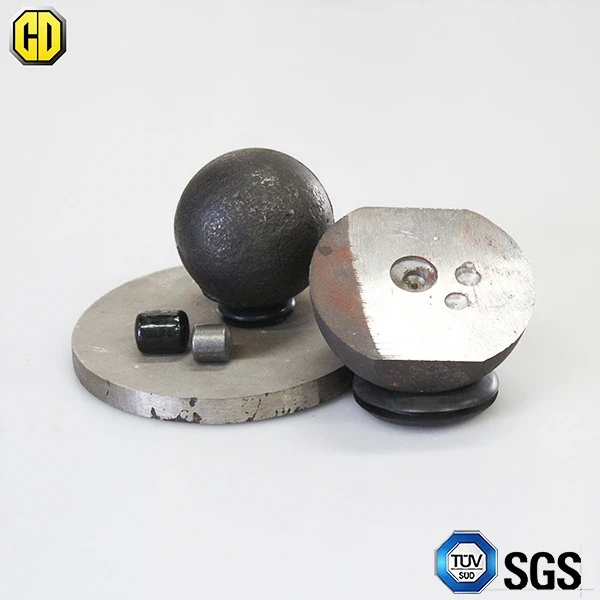Oct . 19, 2025 13:55 Back to list
High Chrome Grinding Media | Wear-Resistant, Low Breakage
The Real-World Guide to high chrome grinding media
I’ve walked more than a few mill floors where the difference between “okay” and “great” is measured in grams per ton and mill uptime. And, to be honest, the chatter has been consistent lately: operators want wear life without sacrificing throughput. That’s where the High Chrome Grinding Ball from KIZUN Industry Zone (Luquan, Shijiazhuang, Hebei, China) has been turning heads—quietly, but decisively.

What it is, and why mills care
High-chrome means alloyed cast iron with chromium in the ≈10–28% range, engineered for abrasion resistance and stable microstructure after heat treatment. In mining, cement finish mills, and even some chemical and petroleum grinding lines, high chrome grinding media helps reduce media consumption, stabilize PSD, and—surprisingly often—improve power efficiency because the balls keep their geometry longer.
Product snapshot (High Chrome Grinding Ball)
| Material | High-chrome cast iron (Cr ≈10–28%, C ≈2.0–3.2%) |
| Hardness (HRC) | ≈58–66 HRC (ASTM E18); real-world may vary by size/heat treatment |
| Sizes | 10–140 mm (common picks: 20, 40, 60, 80, 100 mm) |
| Processing | Casting, quench and temper; microstructure: tempered martensite + carbides (M7C3) |
| Color | Black (as-cast/treated surface) |
| Typical Service Life | ≈1.5–3× vs. low-chrome media in fine grinding duty |
| Industries | Cement, mining, refractory, construction materials, chemical, petroleum |
Process flow (quick but not simplistic)
- Charge design: Cr and C balanced to meet ASTM A532 targets for abrasion resistance.
- Casting: Controlled pouring temperature; riser/runner design to minimize porosity.
- Heat treatment: Austenitize ≈980–1050°C; oil/air quench; temper ≈200–500°C for toughness.
- Testing: HRC (ASTM E18), microstructure check (ASTM E112 methods), abrasion (ASTM G65), drop tests, density measurement.
- QA: Batch traceability, dimensional checks, and sorting—yes, humans still eyeball critical lots.
Where it shines
Finish grinding in cement mills, regrind circuits in base metals, and certain gold circuits where corrosive wear is a headache. Many customers say high chrome grinding media holds roundness better, so classification is steadier. It seems that throughput bumps of ≈1–3% aren’t rare when switching from mixed or low-Cr charges.
Vendor snapshot: how options stack up (condensed)
| Vendor | Chrome content | Typical HRC | Abrasion test (ASTM G65), relative | Notes |
|---|---|---|---|---|
| Chengda High Chrome Grinding Ball | ≈10–28% | 58–66 | Low volume loss (field-backed) | Good in cement and regrind; ISO 9001 factory |
| Vendor X (Low-Cr) | ≈1–3% | 50–58 | Higher loss | Lower cost, shorter life |
| Vendor Y (Forged) | N/A | 55–64 | Medium loss | Great for SAG; chemistry varies |
Customization knobs that matter
- Size mix by chamber: 10–140 mm, blended to your liner profile and PSD target.
- Cr/C balance by ore abrasivity and pH; corrosion/abrasion trade-offs are real.
- Heat-treatment curve tuning for toughness vs. hardness (impact vs. abrasion).
- Lot-by-lot certification: chemistry, hardness maps, drop-test counts.
Field note (condensed case)
SE Asia cement finish mill (Φ3.2×13 m). Switched to 20/40/60 mm high-chrome charge. Media consumption dropped from ≈70 g/t to ≈45 g/t; Blaine held steady at 3300 cm²/g with ~2% lower kWh/t. Operators liked the cleaner separator load. Not a miracle, just consistent.
Standards, testing, and paperwork
Production references include ASTM A532 for abrasion-resistant cast irons, Rockwell hardness per ASTM E18, abrasion per ASTM G65. Factory QMS typically aligns with ISO 9001:2015, and batch certificates can include chemical spectra, HRC readings, micrographs, and drop-test logs. That paperwork, in my experience, saves meetings later.
Origin: KIZUN Industry Zone, Luquan, Shijiazhuang city, Hebei, China. If you’re benchmarking, ask for current HRC maps and an abrasion test snapshot alongside recent heat-treatment parameters. It sounds fussy, but with high chrome grinding media, consistency is king.
- ASTM A532/A532M – Standard Specification for Abrasion-Resistant Cast Irons.
- ASTM E18 – Standard Test Methods for Rockwell Hardness of Metallic Materials.
- ASTM G65 – Standard Test Method for Measuring Abrasion Using the Dry Sand/Rubber Wheel Apparatus.
- ISO 9001:2015 – Quality management systems — Requirements.
-
Expert Insights on Fabrica de Molinos de Bolas: Industry Trends & Global Applications
NewsNov.24,2025
-
Expert Insights on Fabricantes de Bolas de Molienda de Acero: Global Applications & Trends
NewsNov.23,2025
-
Leading Fabricantes de Bolas de Molienda: Your Ultimate Guide to Grinding Balls
NewsNov.23,2025
-
Fabricante de Bolas de Molienda – Quality Grinding Balls for Efficient Industry
NewsNov.23,2025
-
Trusted Proveedores de Medios de Molienda for Efficient Industrial Grinding
NewsNov.22,2025
-
Proveedores de Bolas de Molienda: Your Guide to Top Grinding Ball Suppliers & Industry Insights
NewsNov.22,2025
Realted Products
















